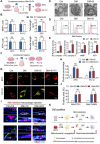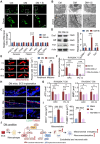Silicon Enhances Functional Mitochondrial Transfer to Improve Neurovascularization in Diabetic Bone Regeneration
- PMID: 40125794
- PMCID: PMC12097102
- DOI: 10.1002/advs.202415459
Silicon Enhances Functional Mitochondrial Transfer to Improve Neurovascularization in Diabetic Bone Regeneration
Abstract
Diabetes mellitus is a metabolic disorder associated with an increased risk of fractures and delayed fracture healing, leading to a higher prevalence of bone defects. Recent advancements in strategies aim at regulating immune responses and enhancing neurovascularization have not met expectations. This study demonstrates that a silicon-based strategy significantly enhances vascularization and innervation, thereby optimizing the repair of diabetic bone defects. Silicon improves mitochondrial function and modulates mitochondrial fission dynamics in macrophages via the Drp1-Mff signaling pathway. Subsequently, functional mitochondria are transferred from macrophages to endothelial and neuronal cells through microvesicles, providing a protective mechanism for blood vessels and peripheral nerves during early wound healing. On this basis, an optimized strategy combining a silicified collagen scaffold with a Drp1-Fis1 interaction inhibitor is used to further regulate mitochondrial fission in macrophages and enhance the trafficking of functional mitochondria into stressed receptor cells. In diabetic mice with critical-sized calvarial defects, the silicon-based treatment significantly promotes vessel formation, nerve growth, and mineralized tissue development. These findings provide therapeutic insights into the role of silicon in promoting diabetic bone regeneration and highlight the importance of intercellular communication in diabetic conditions.
Keywords: bioactive silicon; diabetic bone defects; macrophages; mitochondrial transfer; neural; vascular.
© 2025 The Author(s). Advanced Science published by Wiley‐VCH GmbH.
Conflict of interest statement
The authors declare no conflict of interest.
Figures






References
-
- Zheng Y., Ley S. H., Hu F. B., Nat. Rev. Endocrinol. 2018, 14, 88. - PubMed
-
- Hofbauer L. C., Busse B., Eastell R., Lancet Diabetes Endocrinol. 2022, 10, 207. - PubMed
-
- Napoli N., Chandran M., Pierroz D. D., Nat. Rev. Endocrinol. 2017, 13, 208. - PubMed
-
- Pirola L., Balcerczyk A., Okabe J., El‐Osta A., Nat. Rev. Endocrinol. 2010, 6, 665. - PubMed
MeSH terms
Substances
Grants and funding
LinkOut - more resources
Full Text Sources
Miscellaneous
